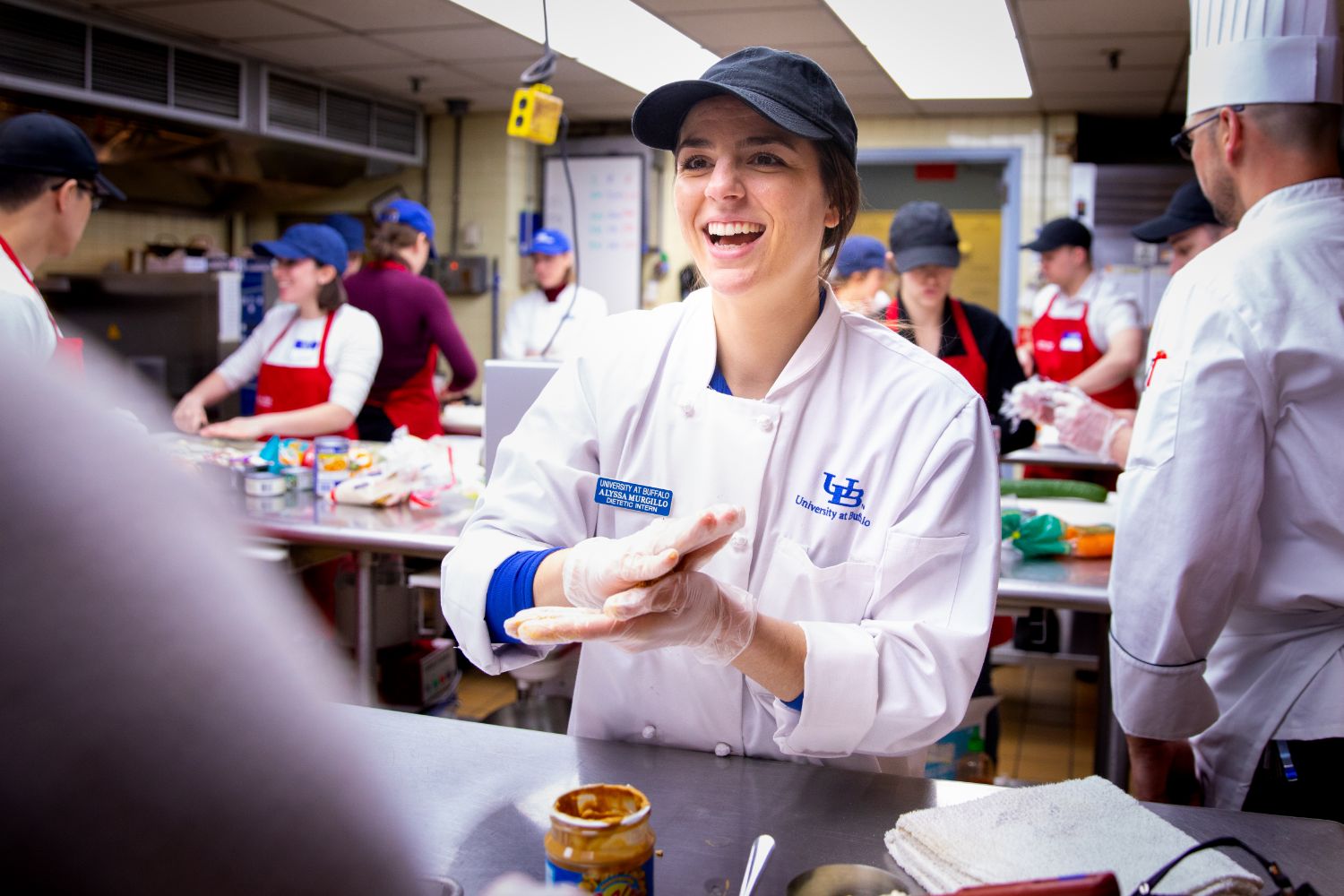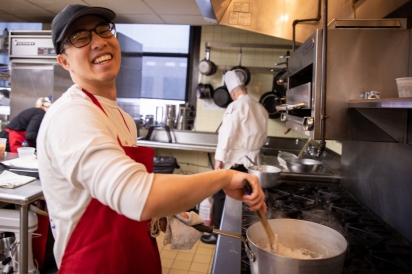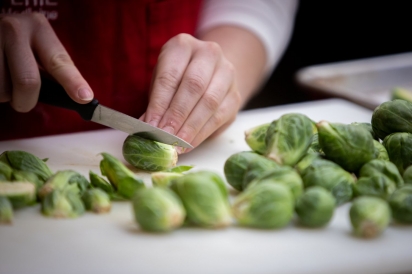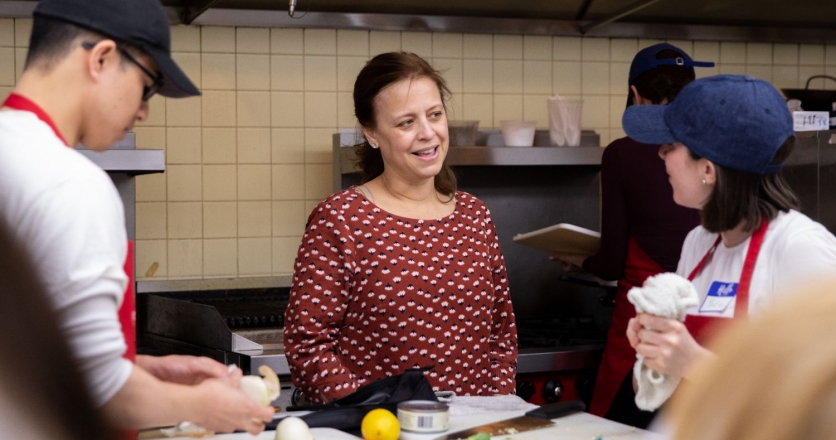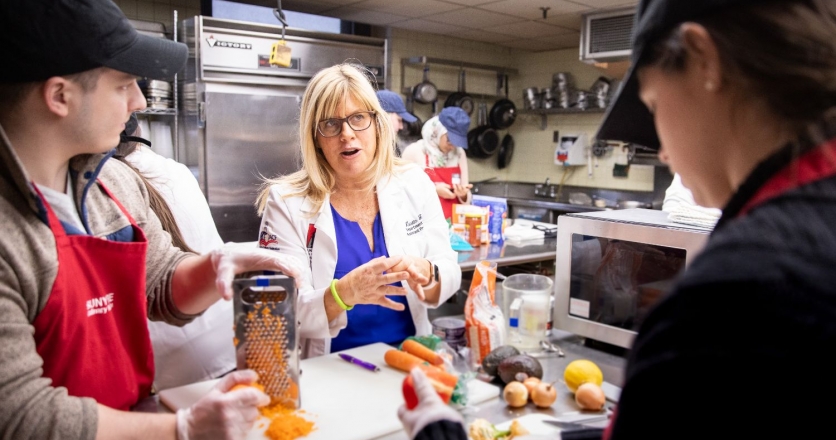The Main Course: A Medical and Culinary School Partnership
When SUNY Erie Community College started offering Introduction to Culinary Medicine to University at Buffalo medical students in 2019, the course’s organizers were worried that no one would sign up. After all, it was unlike anything that had ever been offered at UB, or most medical schools across the country.
As it turned out, medical students were not only happy to spend time in the kitchen but eager for tools to help them engage their future patients around the connection between nutrition and health. “Before we knew it, we had a waiting list. We had to turn people away,” says Kristin Goss, associate professor and chair of ECC’s Culinary Arts Department.
The idea of food as healing, not to mention as a means of preventative medicine, is neither new nor radical. However, the concept often remains a gap in training for both medical and culinary arts students. The average culinary arts program includes just one nutrition class while medical school curriculum does not require a course in nutrition at all, generally offering it only as an elective.
“With this course, the physicians are being taught to talk to their patients about nutrition, preparing food, and eating in a healthy way that helps them avoid intervention, which is more preventative than therapeutic,” says Helen Cappuccino, a clinical assistant professor of surgery in the Jacobs School of Medicine and Biomedical Sciences and an assistant professor of oncology in the breast surgery division at Roswell Park Comprehensive Cancer Center.
Cappuccino, who’s been a key partner since the class’s inception, sees the course as the first step in physicians integrating nutrition into their philosophy and day-to-day practice.
“It’s the unity of three professions—culinary arts, nutrition and medicine—that is key,” explains Cappuccino. “We want to take the culinary medicine approach to patients and really make this a movement.”
Cappuccino and faculty at ECC were inspired by the Goldring Center for Culinary Medicine at Tulane University. The center, which boasts being the first teaching kitchen to operate within a medical school, opened in 2012 and soon after hosted the annual CAFÉ (Center for the Advancement of Foodservice Education) conference.
Dorothy Johnston, a professor and former chair of ECC’s Department of Culinary Arts, was among the educators in attendance at that conference, which focused on the emerging field of culinary medicine.
Inspired by Goldring’s curriculum, Johnston began talking to Goss, with whom she shared an office, about bringing the culinary medicine course to Buffalo. When looking to adapt the course, they knew that leveraging the strengths of their culinary arts students was vital.
Over their decades in the department, Johnston and Goss have witnessed many changes, including the expansion of the college to North and City campuses, and shifts in the students the program attracts. Until pretty recently, you could count on the typical culinary arts student to be young and aiming to be a chef, ready to submit to the long hours and rigorous life of a line cook during and after completing their two-year associate degree.
However, in the last decade, the program has drawn another kind of student: middle-aged adults who love cooking and are looking to build a new career. These students often have families and can’t sacrifice the time or weather the unpredictability it can take to become a career chef. Instead of a Michelin-starred restaurant, the setting of their dream job may be at an institution like an assisted living facility or hospital.
While Johnston and Goss had noticed an evolution in their students, they realized their curriculum hadn’t kept up. “I looked at our department’s nutrition class, the syllabus I’d inherited from a previous professor, and I thought, ‘this can be better,’” says Goss.
She was driven in this undertaking by personal experience: 11 years ago, she was diagnosed with breast cancer. The news shook her to her core—and ultimately transformed her relationship to food. “Even after the chemotherapy was done, everything I ate made me sick,” she says, with a shrug of exasperation.
Goss started an elimination diet and found that anything with high gluten, high sugar or dairy made her body ache. She started to focus her diet on vegetables and lean proteins. “I wanted to heal myself, for this to never happen again.”
Soon she wanted to learn how to grow what she could to know exactly what was in the food she was eating. Her experience inspired her to start The Learning Garden by ECC at Canalside, which has acted as a classroom for growing and preparing food since 2014. The initiative, as well as the culinary medicine course, got off the ground due to funding from the Statler Foundation, which is invested in supporting students entering the hospitality industry.
When the four-week Introduction to Culinary Medicine course, which is based on the accredited and evidence-based Goldring Center model, launched in 2019, medical students were excited to sign up. Not only was the course a novelty—being in ECC’s commercial kitchen is a welcome change of scenery—they wanted to add culinary skills and nutrition to their toolkit.
According to researchers in the UB Dietetics Internship program, prior to the course 27 percent of medical students did not identify cooking as a priority while 45 percent rated their cooking skills as below average. After learning alongside culinarians, 100 percent of students said cooking is a priority, and all felt more confident in their cooking abilities.
Another particularly effective feature of the course is a poverty simulation, in which students are challenged to create a healthy meal for a family with constraints familiar to many of their patients. With a budget of just 12 dollars, students are given the task of getting to and from the grocery store on public transportation and buying ingredients to make a healthy meal.
“I think it’s a really eye-opening experience for students to see what patients deal with, and the reality of trying to effect a good diet,” says Cappuccino, who, like Goss and Johnston, is so passionate about the course’s mission that she volunteers her time to it. As members of the local chapter of Chaînes des Rôtisseurs, an international food and wine society, all three also understand that joy is central to the experience of both cooking and eating.
“An important part of the course is the community aspect: preparing and then also enjoying meals together,” says Goss.
After a hiatus due to the pandemic, they’re looking forward to offering the course to UB students again in spring 2022. The course will also be one of the building blocks of a new innovative associate degree in culinary nutrition that ECC’s Culinary Arts Department will offer starting this fall.
Above Goss’s desk she’s pinned a thank you card from the course’s inaugural participants, whose handwritten notes gush appreciation and radiate joy. “Thank you for everything,” writes one medical student. “This class has honestly been the highlight of my medical school experience.”
On defeating days, when she’s overwhelmed by the world or the problems her students face, she looks at their messages. “I know we made a difference in at least 14 future physicians,” she says. And when you’re trying to start a movement, every victory matters.


